Exploring Women's Representation in Saudi Art: A Critical Study
VerifiedAdded on 2020/05/28
|47
|7283
|189
AI Summary
The study delves into the complex interplay between gender roles and artistic expression in the Middle East. By examining paintings, photography, and contemporary art forms, it highlights how women have navigated societal constraints to assert their presence in the art world. The paper draws on a range of sources, including dissertations and journal articles, to provide a nuanced understanding of women's contributions to Middle Eastern art. It also discusses the broader implications of these artistic endeavors for gender equality and cultural transformation.
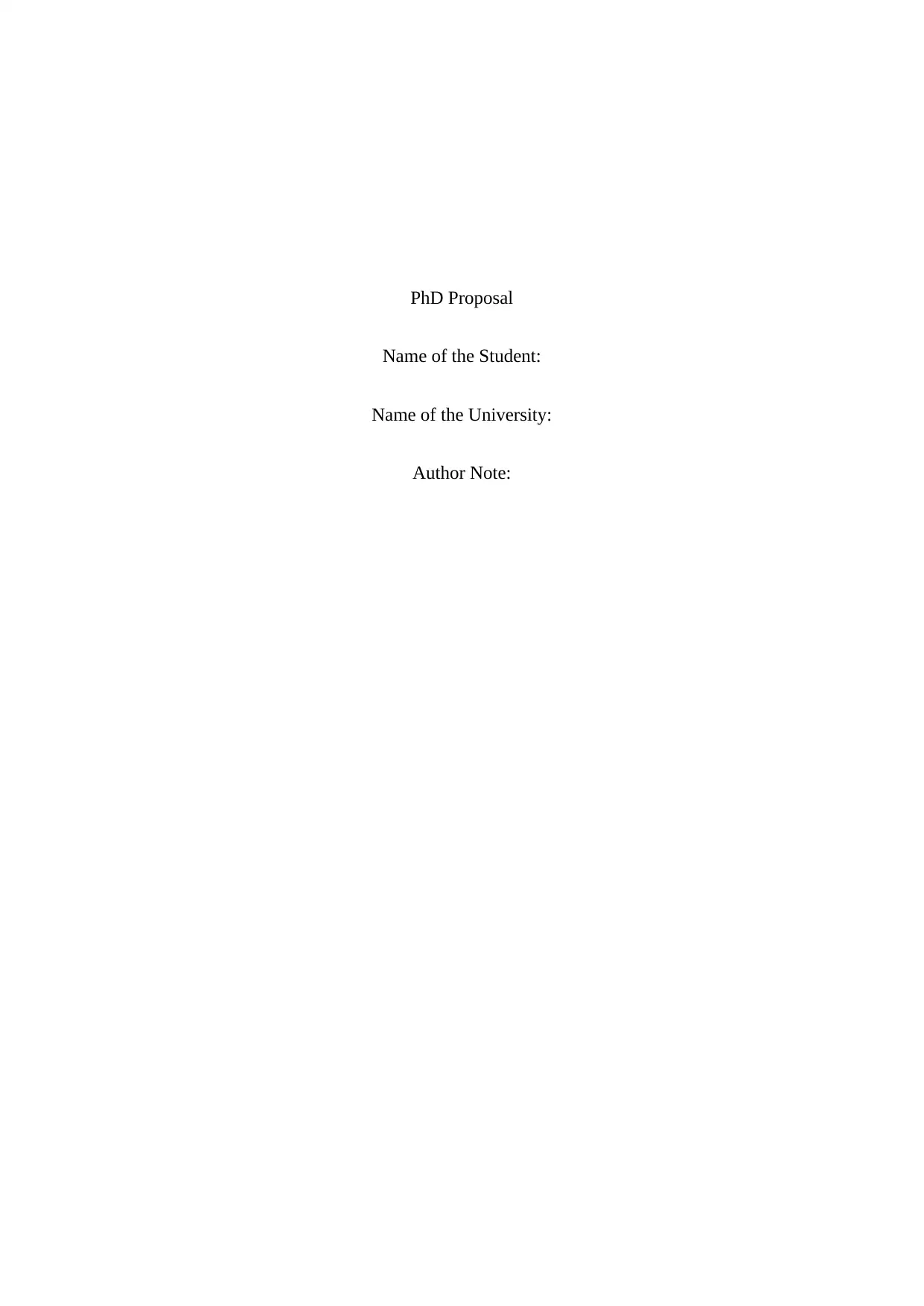
PhD Proposal
Name of the Student:
Name of the University:
Author Note:
Name of the Student:
Name of the University:
Author Note:
Paraphrase This Document
Need a fresh take? Get an instant paraphrase of this document with our AI Paraphraser
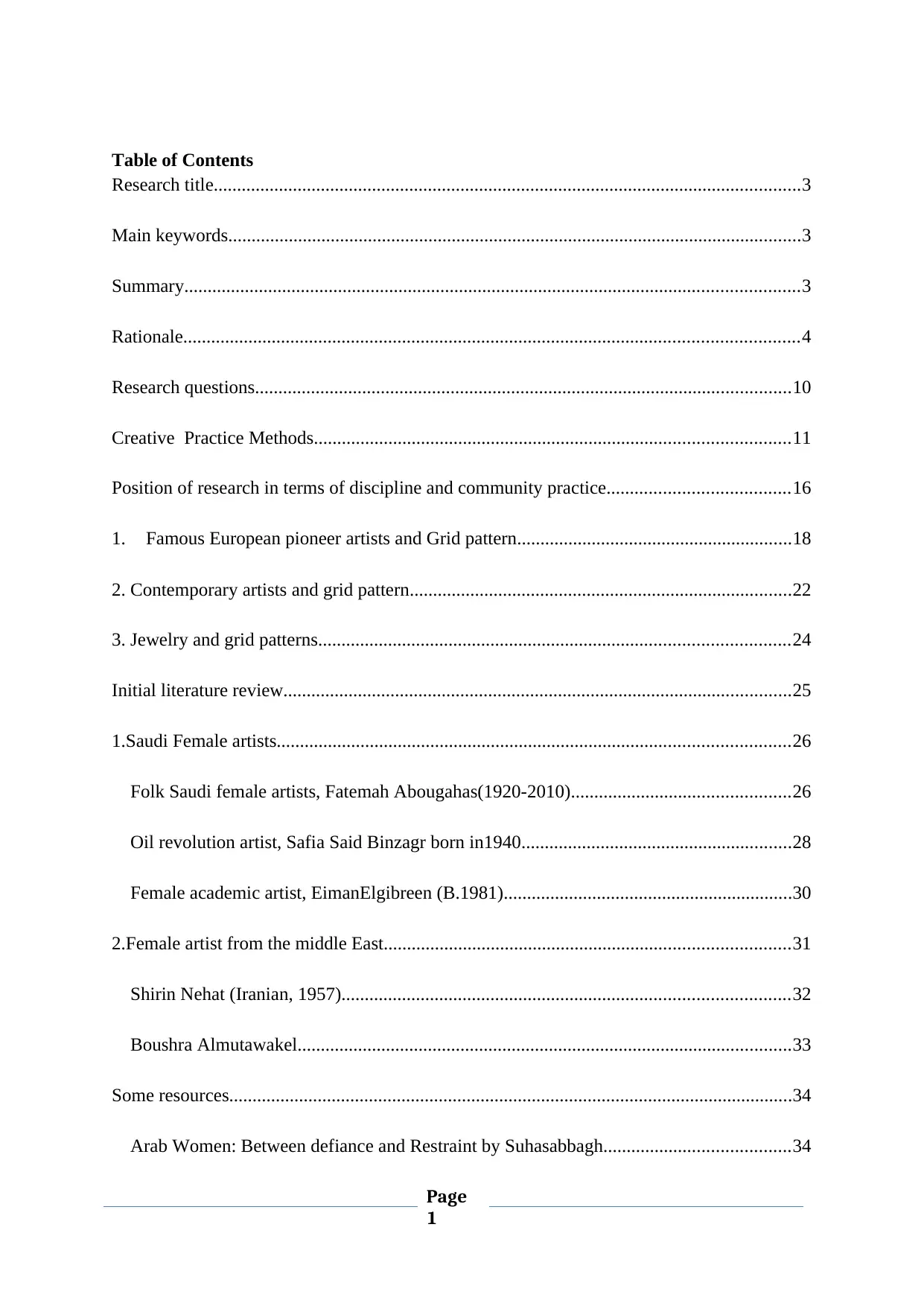
Table of Contents
Research title..............................................................................................................................3
Main keywords...........................................................................................................................3
Summary....................................................................................................................................3
Rationale....................................................................................................................................4
Research questions...................................................................................................................10
Creative Practice Methods......................................................................................................11
Position of research in terms of discipline and community practice.......................................16
1. Famous European pioneer artists and Grid pattern...........................................................18
2. Contemporary artists and grid pattern..................................................................................22
3. Jewelry and grid patterns.....................................................................................................24
Initial literature review.............................................................................................................25
1.Saudi Female artists..............................................................................................................26
Folk Saudi female artists, Fatemah Abougahas(1920-2010)...............................................26
Oil revolution artist, Safia Said Binzagr born in1940..........................................................28
Female academic artist, EimanElgibreen (B.1981)..............................................................30
2.Female artist from the middle East.......................................................................................31
Shirin Nehat (Iranian, 1957)................................................................................................32
Boushra Almutawakel..........................................................................................................33
Some resources.........................................................................................................................34
Arab Women: Between defiance and Restraint by Suhasabbagh........................................34
Page
1
Research title..............................................................................................................................3
Main keywords...........................................................................................................................3
Summary....................................................................................................................................3
Rationale....................................................................................................................................4
Research questions...................................................................................................................10
Creative Practice Methods......................................................................................................11
Position of research in terms of discipline and community practice.......................................16
1. Famous European pioneer artists and Grid pattern...........................................................18
2. Contemporary artists and grid pattern..................................................................................22
3. Jewelry and grid patterns.....................................................................................................24
Initial literature review.............................................................................................................25
1.Saudi Female artists..............................................................................................................26
Folk Saudi female artists, Fatemah Abougahas(1920-2010)...............................................26
Oil revolution artist, Safia Said Binzagr born in1940..........................................................28
Female academic artist, EimanElgibreen (B.1981)..............................................................30
2.Female artist from the middle East.......................................................................................31
Shirin Nehat (Iranian, 1957)................................................................................................32
Boushra Almutawakel..........................................................................................................33
Some resources.........................................................................................................................34
Arab Women: Between defiance and Restraint by Suhasabbagh........................................34
Page
1
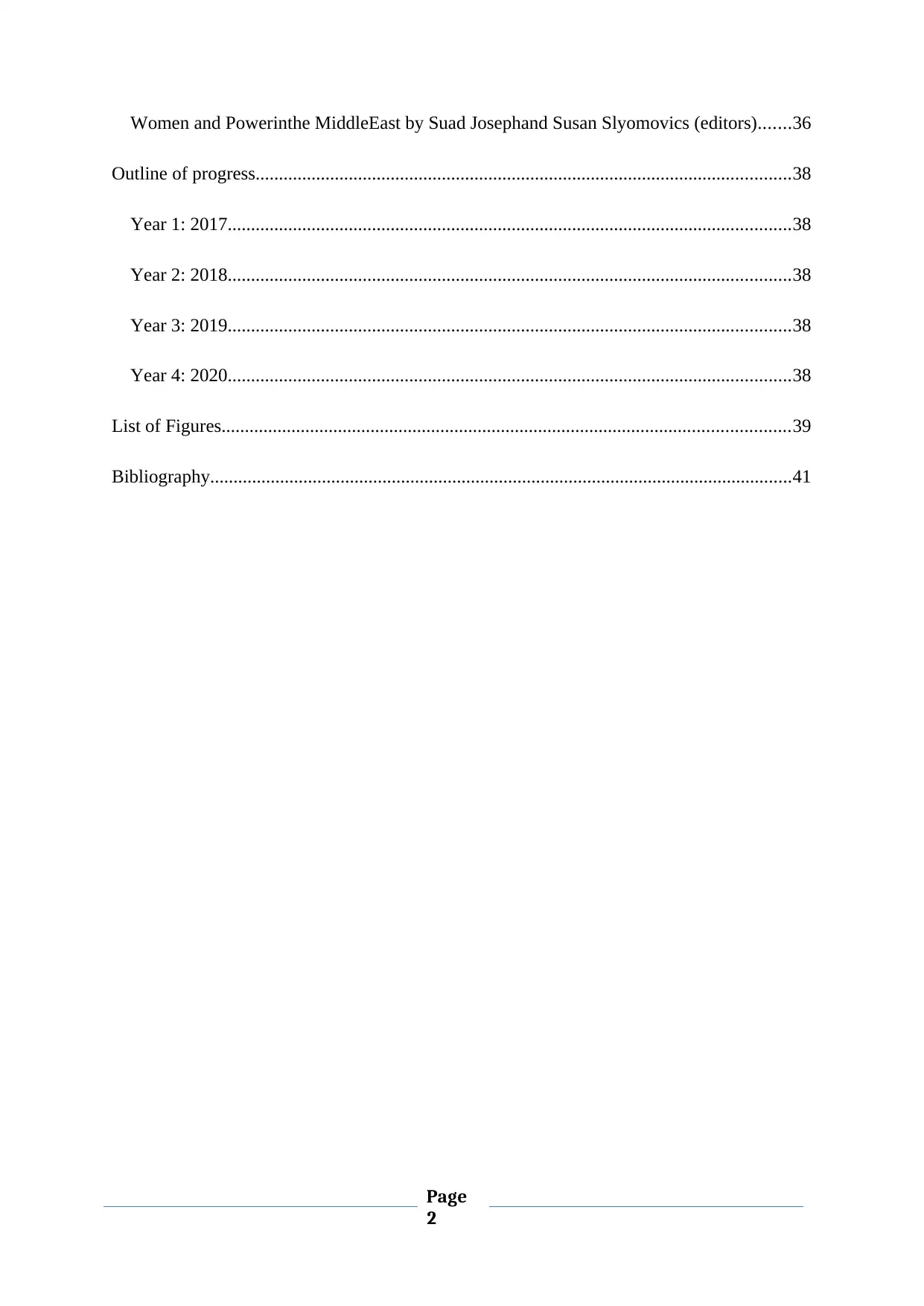
Women and Powerinthe MiddleEast by Suad Josephand Susan Slyomovics (editors).......36
Outline of progress...................................................................................................................38
Year 1: 2017.........................................................................................................................38
Year 2: 2018.........................................................................................................................38
Year 3: 2019.........................................................................................................................38
Year 4: 2020.........................................................................................................................38
List of Figures..........................................................................................................................39
Bibliography.............................................................................................................................41
Page
2
Outline of progress...................................................................................................................38
Year 1: 2017.........................................................................................................................38
Year 2: 2018.........................................................................................................................38
Year 3: 2019.........................................................................................................................38
Year 4: 2020.........................................................................................................................38
List of Figures..........................................................................................................................39
Bibliography.............................................................................................................................41
Page
2
⊘ This is a preview!⊘
Do you want full access?
Subscribe today to unlock all pages.

Trusted by 1+ million students worldwide
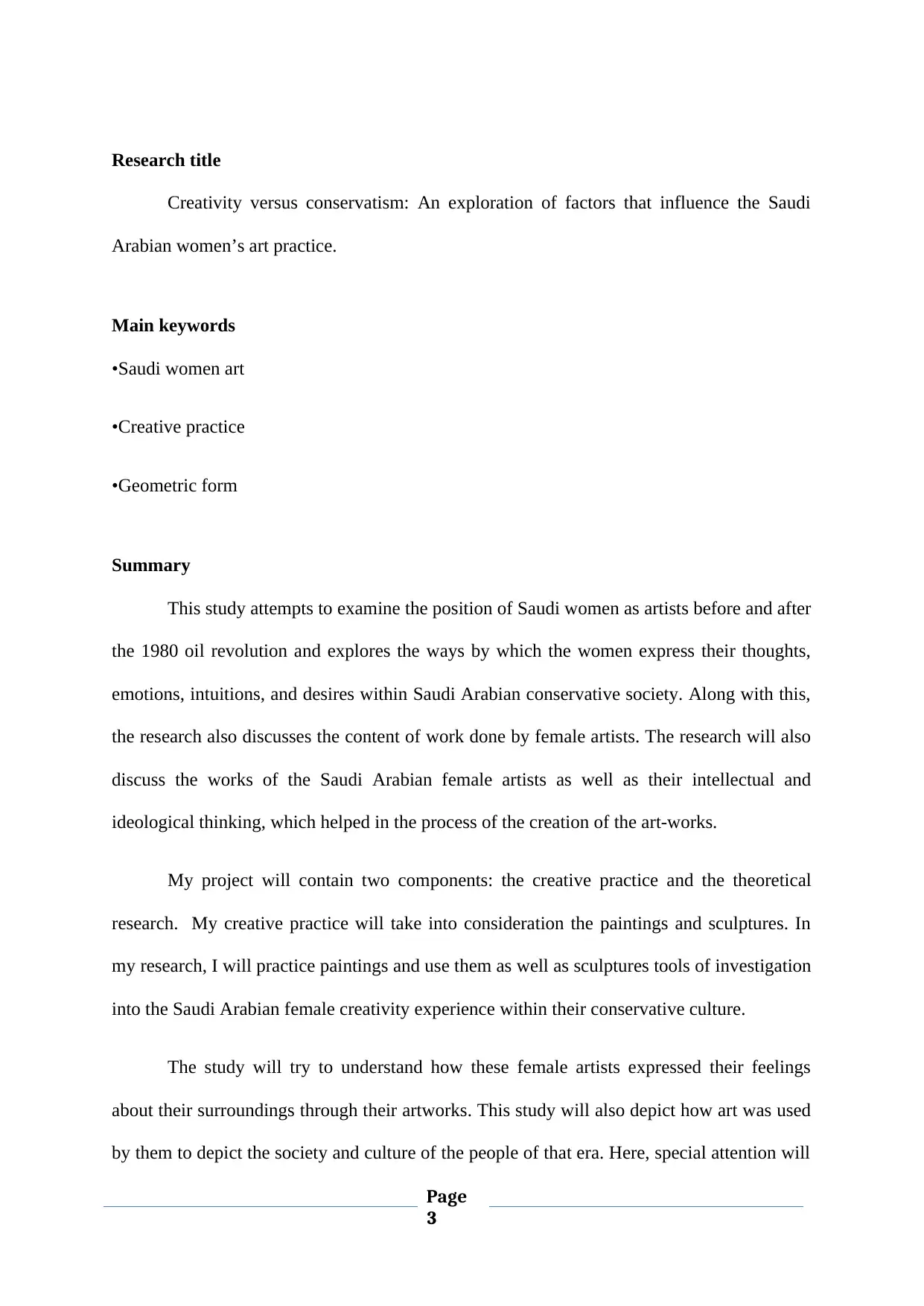
Research title
Creativity versus conservatism: An exploration of factors that influence the Saudi
Arabian women’s art practice.
Main keywords
•Saudi women art
•Creative practice
•Geometric form
Summary
This study attempts to examine the position of Saudi women as artists before and after
the 1980 oil revolution and explores the ways by which the women express their thoughts,
emotions, intuitions, and desires within Saudi Arabian conservative society. Along with this,
the research also discusses the content of work done by female artists. The research will also
discuss the works of the Saudi Arabian female artists as well as their intellectual and
ideological thinking, which helped in the process of the creation of the art-works.
My project will contain two components: the creative practice and the theoretical
research. My creative practice will take into consideration the paintings and sculptures. In
my research, I will practice paintings and use them as well as sculptures tools of investigation
into the Saudi Arabian female creativity experience within their conservative culture.
The study will try to understand how these female artists expressed their feelings
about their surroundings through their artworks. This study will also depict how art was used
by them to depict the society and culture of the people of that era. Here, special attention will
Page
3
Creativity versus conservatism: An exploration of factors that influence the Saudi
Arabian women’s art practice.
Main keywords
•Saudi women art
•Creative practice
•Geometric form
Summary
This study attempts to examine the position of Saudi women as artists before and after
the 1980 oil revolution and explores the ways by which the women express their thoughts,
emotions, intuitions, and desires within Saudi Arabian conservative society. Along with this,
the research also discusses the content of work done by female artists. The research will also
discuss the works of the Saudi Arabian female artists as well as their intellectual and
ideological thinking, which helped in the process of the creation of the art-works.
My project will contain two components: the creative practice and the theoretical
research. My creative practice will take into consideration the paintings and sculptures. In
my research, I will practice paintings and use them as well as sculptures tools of investigation
into the Saudi Arabian female creativity experience within their conservative culture.
The study will try to understand how these female artists expressed their feelings
about their surroundings through their artworks. This study will also depict how art was used
by them to depict the society and culture of the people of that era. Here, special attention will
Page
3
Paraphrase This Document
Need a fresh take? Get an instant paraphrase of this document with our AI Paraphraser
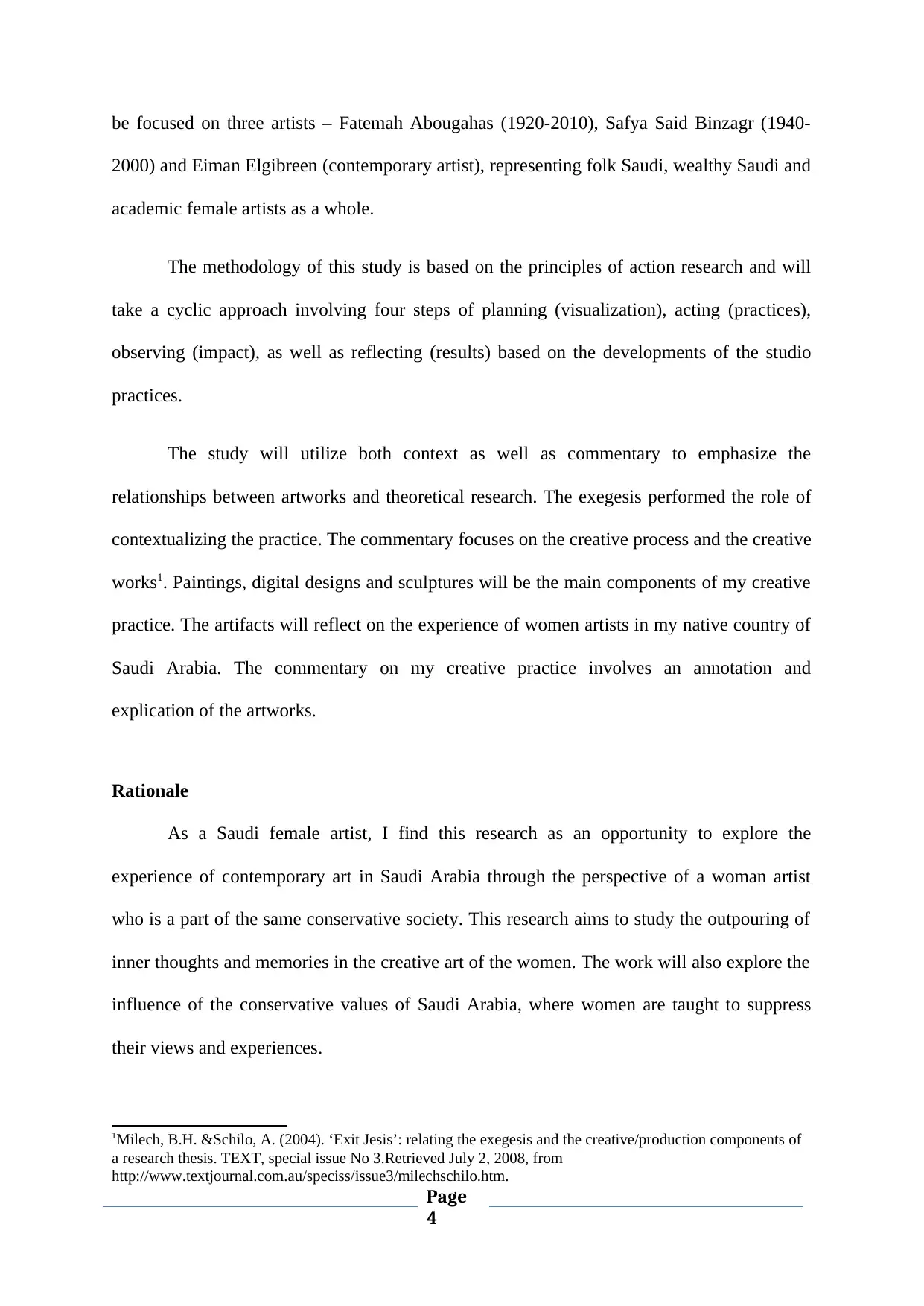
be focused on three artists – Fatemah Abougahas (1920-2010), Safya Said Binzagr (1940-
2000) and Eiman Elgibreen (contemporary artist), representing folk Saudi, wealthy Saudi and
academic female artists as a whole.
The methodology of this study is based on the principles of action research and will
take a cyclic approach involving four steps of planning (visualization), acting (practices),
observing (impact), as well as reflecting (results) based on the developments of the studio
practices.
The study will utilize both context as well as commentary to emphasize the
relationships between artworks and theoretical research. The exegesis performed the role of
contextualizing the practice. The commentary focuses on the creative process and the creative
works1. Paintings, digital designs and sculptures will be the main components of my creative
practice. The artifacts will reflect on the experience of women artists in my native country of
Saudi Arabia. The commentary on my creative practice involves an annotation and
explication of the artworks.
Rationale
As a Saudi female artist, I find this research as an opportunity to explore the
experience of contemporary art in Saudi Arabia through the perspective of a woman artist
who is a part of the same conservative society. This research aims to study the outpouring of
inner thoughts and memories in the creative art of the women. The work will also explore the
influence of the conservative values of Saudi Arabia, where women are taught to suppress
their views and experiences.
1Milech, B.H. &Schilo, A. (2004). ‘Exit Jesis’: relating the exegesis and the creative/production components of
a research thesis. TEXT, special issue No 3.Retrieved July 2, 2008, from
http://www.textjournal.com.au/speciss/issue3/milechschilo.htm.
Page
4
2000) and Eiman Elgibreen (contemporary artist), representing folk Saudi, wealthy Saudi and
academic female artists as a whole.
The methodology of this study is based on the principles of action research and will
take a cyclic approach involving four steps of planning (visualization), acting (practices),
observing (impact), as well as reflecting (results) based on the developments of the studio
practices.
The study will utilize both context as well as commentary to emphasize the
relationships between artworks and theoretical research. The exegesis performed the role of
contextualizing the practice. The commentary focuses on the creative process and the creative
works1. Paintings, digital designs and sculptures will be the main components of my creative
practice. The artifacts will reflect on the experience of women artists in my native country of
Saudi Arabia. The commentary on my creative practice involves an annotation and
explication of the artworks.
Rationale
As a Saudi female artist, I find this research as an opportunity to explore the
experience of contemporary art in Saudi Arabia through the perspective of a woman artist
who is a part of the same conservative society. This research aims to study the outpouring of
inner thoughts and memories in the creative art of the women. The work will also explore the
influence of the conservative values of Saudi Arabia, where women are taught to suppress
their views and experiences.
1Milech, B.H. &Schilo, A. (2004). ‘Exit Jesis’: relating the exegesis and the creative/production components of
a research thesis. TEXT, special issue No 3.Retrieved July 2, 2008, from
http://www.textjournal.com.au/speciss/issue3/milechschilo.htm.
Page
4
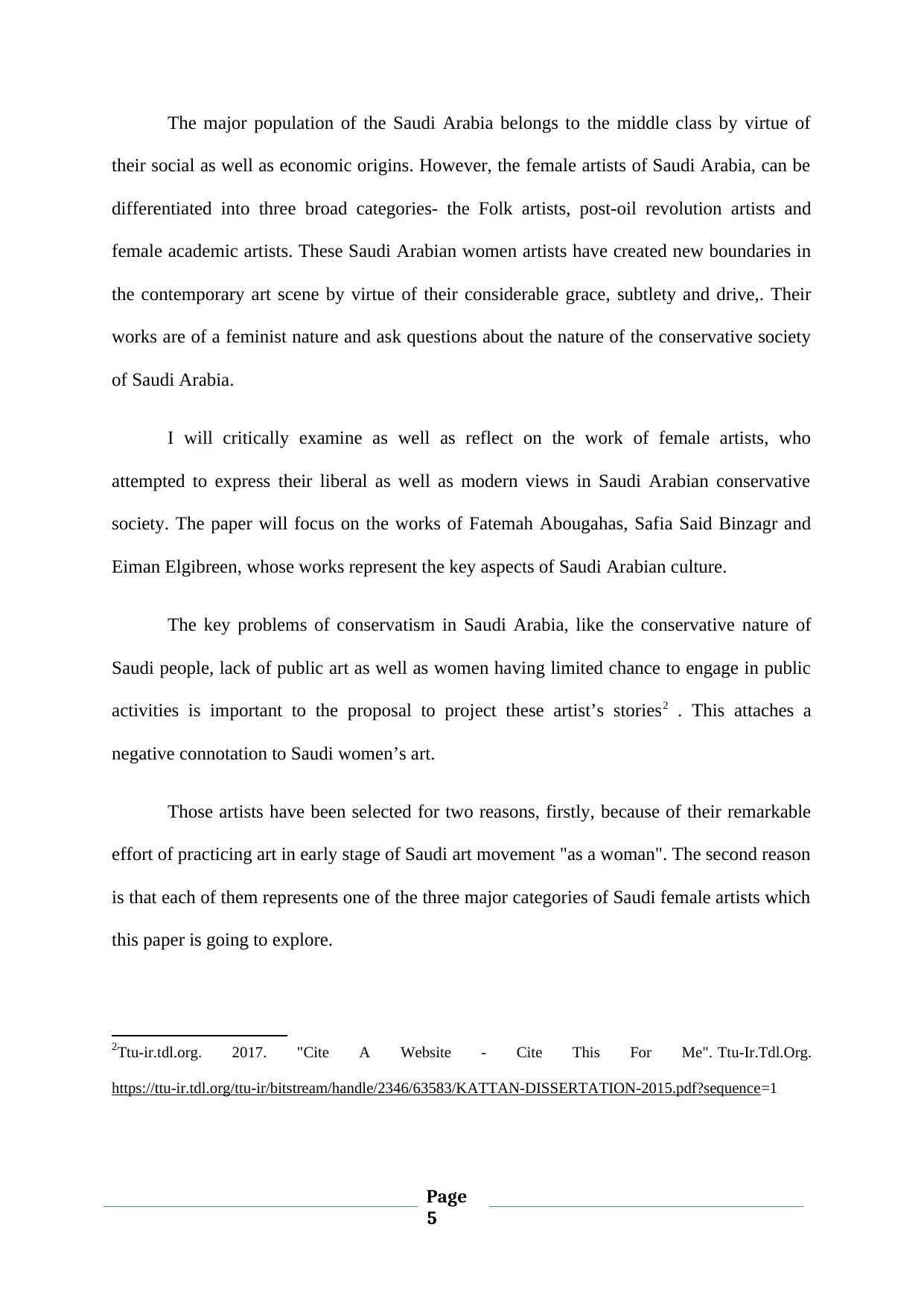
The major population of the Saudi Arabia belongs to the middle class by virtue of
their social as well as economic origins. However, the female artists of Saudi Arabia, can be
differentiated into three broad categories- the Folk artists, post-oil revolution artists and
female academic artists. These Saudi Arabian women artists have created new boundaries in
the contemporary art scene by virtue of their considerable grace, subtlety and drive,. Their
works are of a feminist nature and ask questions about the nature of the conservative society
of Saudi Arabia.
I will critically examine as well as reflect on the work of female artists, who
attempted to express their liberal as well as modern views in Saudi Arabian conservative
society. The paper will focus on the works of Fatemah Abougahas, Safia Said Binzagr and
Eiman Elgibreen, whose works represent the key aspects of Saudi Arabian culture.
The key problems of conservatism in Saudi Arabia, like the conservative nature of
Saudi people, lack of public art as well as women having limited chance to engage in public
activities is important to the proposal to project these artist’s stories2 . This attaches a
negative connotation to Saudi women’s art.
Those artists have been selected for two reasons, firstly, because of their remarkable
effort of practicing art in early stage of Saudi art movement "as a woman". The second reason
is that each of them represents one of the three major categories of Saudi female artists which
this paper is going to explore.
2Ttu-ir.tdl.org. 2017. "Cite A Website - Cite This For Me". Ttu-Ir.Tdl.Org.
https://ttu-ir.tdl.org/ttu-ir/bitstream/handle/2346/63583/KATTAN-DISSERTATION-2015.pdf?sequence=1
Page
5
their social as well as economic origins. However, the female artists of Saudi Arabia, can be
differentiated into three broad categories- the Folk artists, post-oil revolution artists and
female academic artists. These Saudi Arabian women artists have created new boundaries in
the contemporary art scene by virtue of their considerable grace, subtlety and drive,. Their
works are of a feminist nature and ask questions about the nature of the conservative society
of Saudi Arabia.
I will critically examine as well as reflect on the work of female artists, who
attempted to express their liberal as well as modern views in Saudi Arabian conservative
society. The paper will focus on the works of Fatemah Abougahas, Safia Said Binzagr and
Eiman Elgibreen, whose works represent the key aspects of Saudi Arabian culture.
The key problems of conservatism in Saudi Arabia, like the conservative nature of
Saudi people, lack of public art as well as women having limited chance to engage in public
activities is important to the proposal to project these artist’s stories2 . This attaches a
negative connotation to Saudi women’s art.
Those artists have been selected for two reasons, firstly, because of their remarkable
effort of practicing art in early stage of Saudi art movement "as a woman". The second reason
is that each of them represents one of the three major categories of Saudi female artists which
this paper is going to explore.
2Ttu-ir.tdl.org. 2017. "Cite A Website - Cite This For Me". Ttu-Ir.Tdl.Org.
https://ttu-ir.tdl.org/ttu-ir/bitstream/handle/2346/63583/KATTAN-DISSERTATION-2015.pdf?sequence=1
Page
5
⊘ This is a preview!⊘
Do you want full access?
Subscribe today to unlock all pages.

Trusted by 1+ million students worldwide
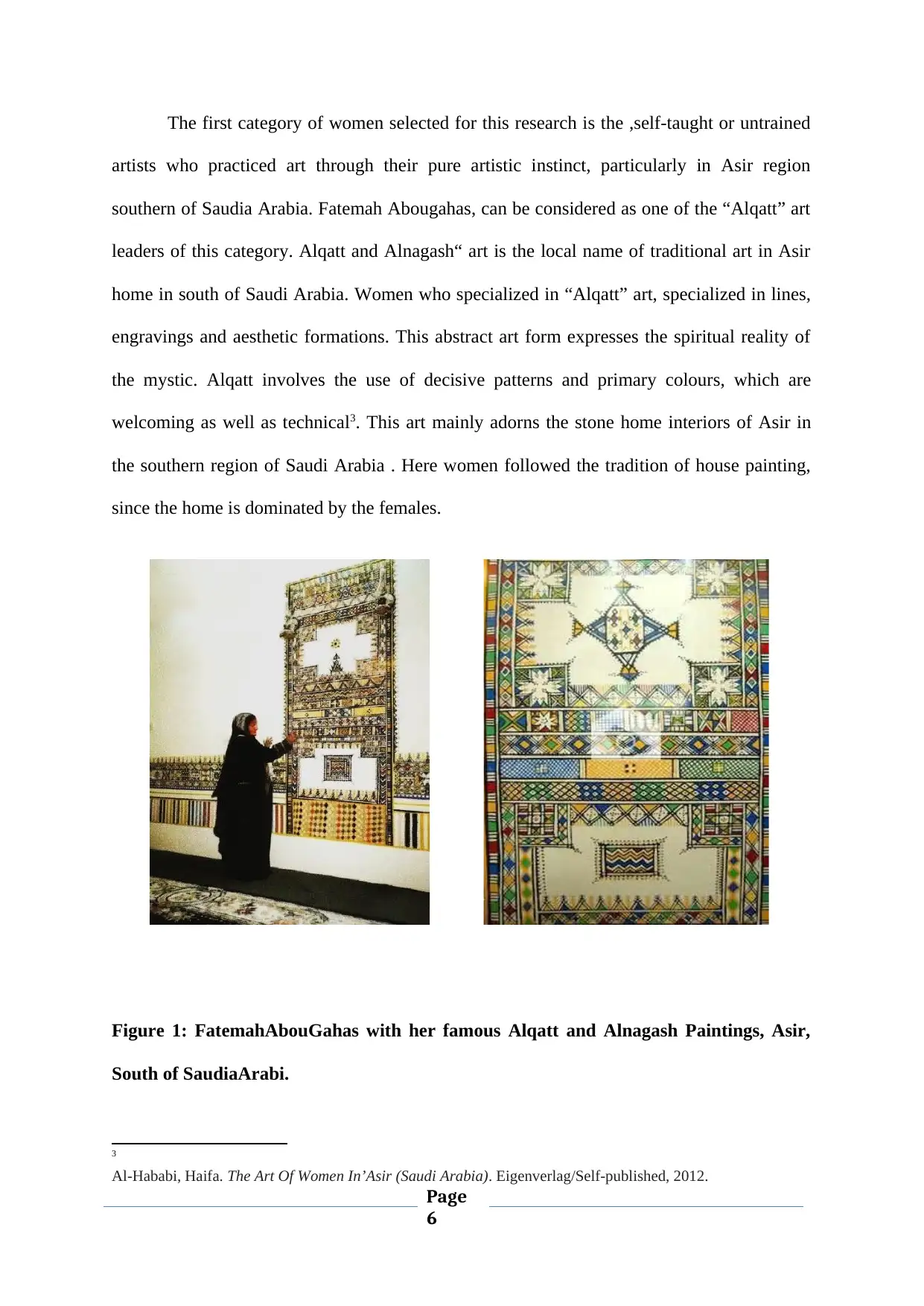
The first category of women selected for this research is the ,self-taught or untrained
artists who practiced art through their pure artistic instinct, particularly in Asir region
southern of Saudia Arabia. Fatemah Abougahas, can be considered as one of the “Alqatt” art
leaders of this category. Alqatt and Alnagash“ art is the local name of traditional art in Asir
home in south of Saudi Arabia. Women who specialized in “Alqatt” art, specialized in lines,
engravings and aesthetic formations. This abstract art form expresses the spiritual reality of
the mystic. Alqatt involves the use of decisive patterns and primary colours, which are
welcoming as well as technical3. This art mainly adorns the stone home interiors of Asir in
the southern region of Saudi Arabia . Here women followed the tradition of house painting,
since the home is dominated by the females.
Figure 1: FatemahAbouGahas with her famous Alqatt and Alnagash Paintings, Asir,
South of SaudiaArabi.
3
Al-Hababi, Haifa. The Art Of Women In’Asir (Saudi Arabia). Eigenverlag/Self-published, 2012.
Page
6
artists who practiced art through their pure artistic instinct, particularly in Asir region
southern of Saudia Arabia. Fatemah Abougahas, can be considered as one of the “Alqatt” art
leaders of this category. Alqatt and Alnagash“ art is the local name of traditional art in Asir
home in south of Saudi Arabia. Women who specialized in “Alqatt” art, specialized in lines,
engravings and aesthetic formations. This abstract art form expresses the spiritual reality of
the mystic. Alqatt involves the use of decisive patterns and primary colours, which are
welcoming as well as technical3. This art mainly adorns the stone home interiors of Asir in
the southern region of Saudi Arabia . Here women followed the tradition of house painting,
since the home is dominated by the females.
Figure 1: FatemahAbouGahas with her famous Alqatt and Alnagash Paintings, Asir,
South of SaudiaArabi.
3
Al-Hababi, Haifa. The Art Of Women In’Asir (Saudi Arabia). Eigenverlag/Self-published, 2012.
Page
6
Paraphrase This Document
Need a fresh take? Get an instant paraphrase of this document with our AI Paraphraser

Page
7
7
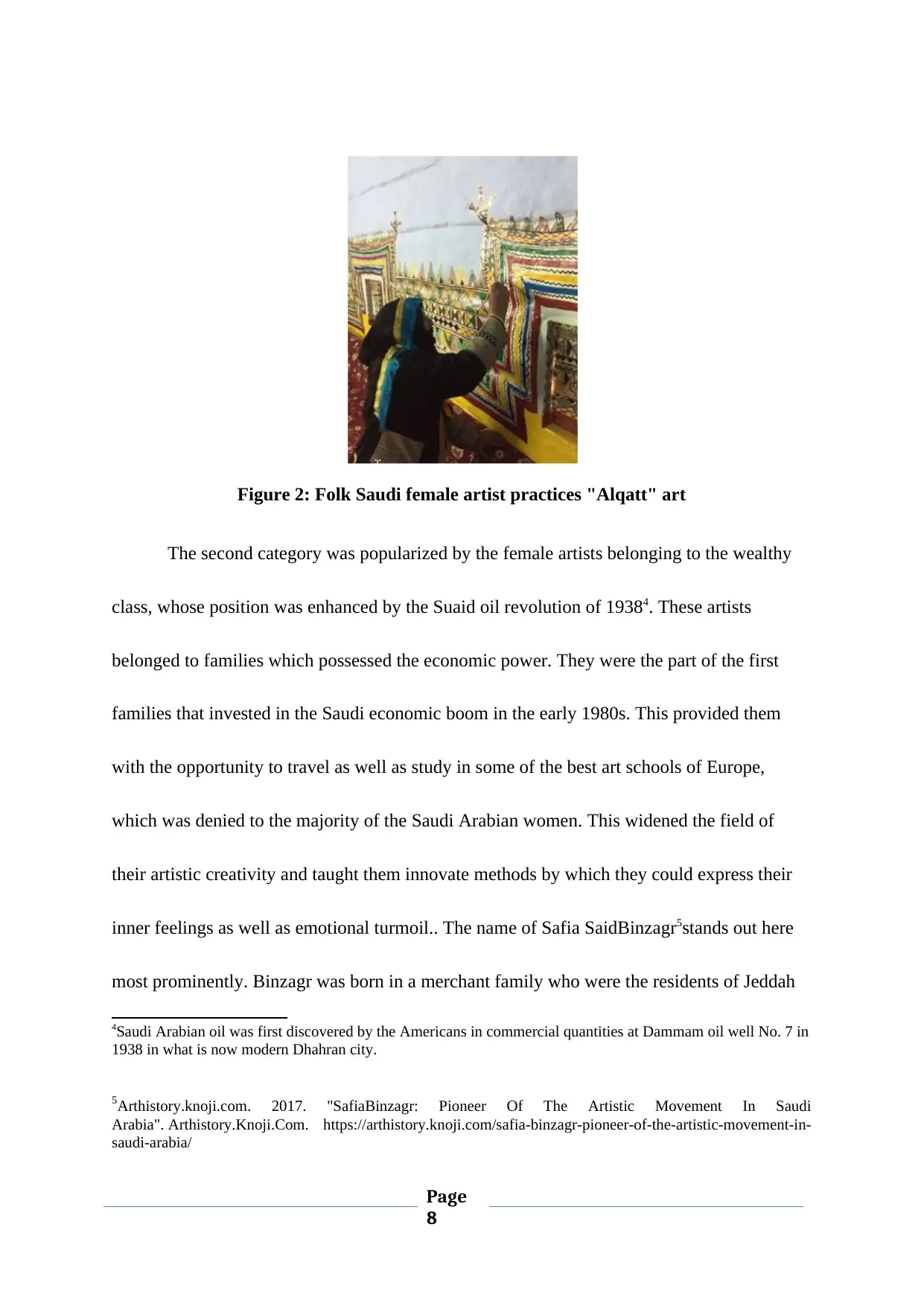
Figure 2: Folk Saudi female artist practices "Alqatt" art
The second category was popularized by the female artists belonging to the wealthy
class, whose position was enhanced by the Suaid oil revolution of 19384. These artists
belonged to families which possessed the economic power. They were the part of the first
families that invested in the Saudi economic boom in the early 1980s. This provided them
with the opportunity to travel as well as study in some of the best art schools of Europe,
which was denied to the majority of the Saudi Arabian women. This widened the field of
their artistic creativity and taught them innovate methods by which they could express their
inner feelings as well as emotional turmoil.. The name of Safia SaidBinzagr5stands out here
most prominently. Binzagr was born in a merchant family who were the residents of Jeddah
4Saudi Arabian oil was first discovered by the Americans in commercial quantities at Dammam oil well No. 7 in
1938 in what is now modern Dhahran city.
5Arthistory.knoji.com. 2017. "SafiaBinzagr: Pioneer Of The Artistic Movement In Saudi
Arabia". Arthistory.Knoji.Com. https://arthistory.knoji.com/safia-binzagr-pioneer-of-the-artistic-movement-in-
saudi-arabia/
Page
8
The second category was popularized by the female artists belonging to the wealthy
class, whose position was enhanced by the Suaid oil revolution of 19384. These artists
belonged to families which possessed the economic power. They were the part of the first
families that invested in the Saudi economic boom in the early 1980s. This provided them
with the opportunity to travel as well as study in some of the best art schools of Europe,
which was denied to the majority of the Saudi Arabian women. This widened the field of
their artistic creativity and taught them innovate methods by which they could express their
inner feelings as well as emotional turmoil.. The name of Safia SaidBinzagr5stands out here
most prominently. Binzagr was born in a merchant family who were the residents of Jeddah
4Saudi Arabian oil was first discovered by the Americans in commercial quantities at Dammam oil well No. 7 in
1938 in what is now modern Dhahran city.
5Arthistory.knoji.com. 2017. "SafiaBinzagr: Pioneer Of The Artistic Movement In Saudi
Arabia". Arthistory.Knoji.Com. https://arthistory.knoji.com/safia-binzagr-pioneer-of-the-artistic-movement-in-
saudi-arabia/
Page
8
⊘ This is a preview!⊘
Do you want full access?
Subscribe today to unlock all pages.

Trusted by 1+ million students worldwide
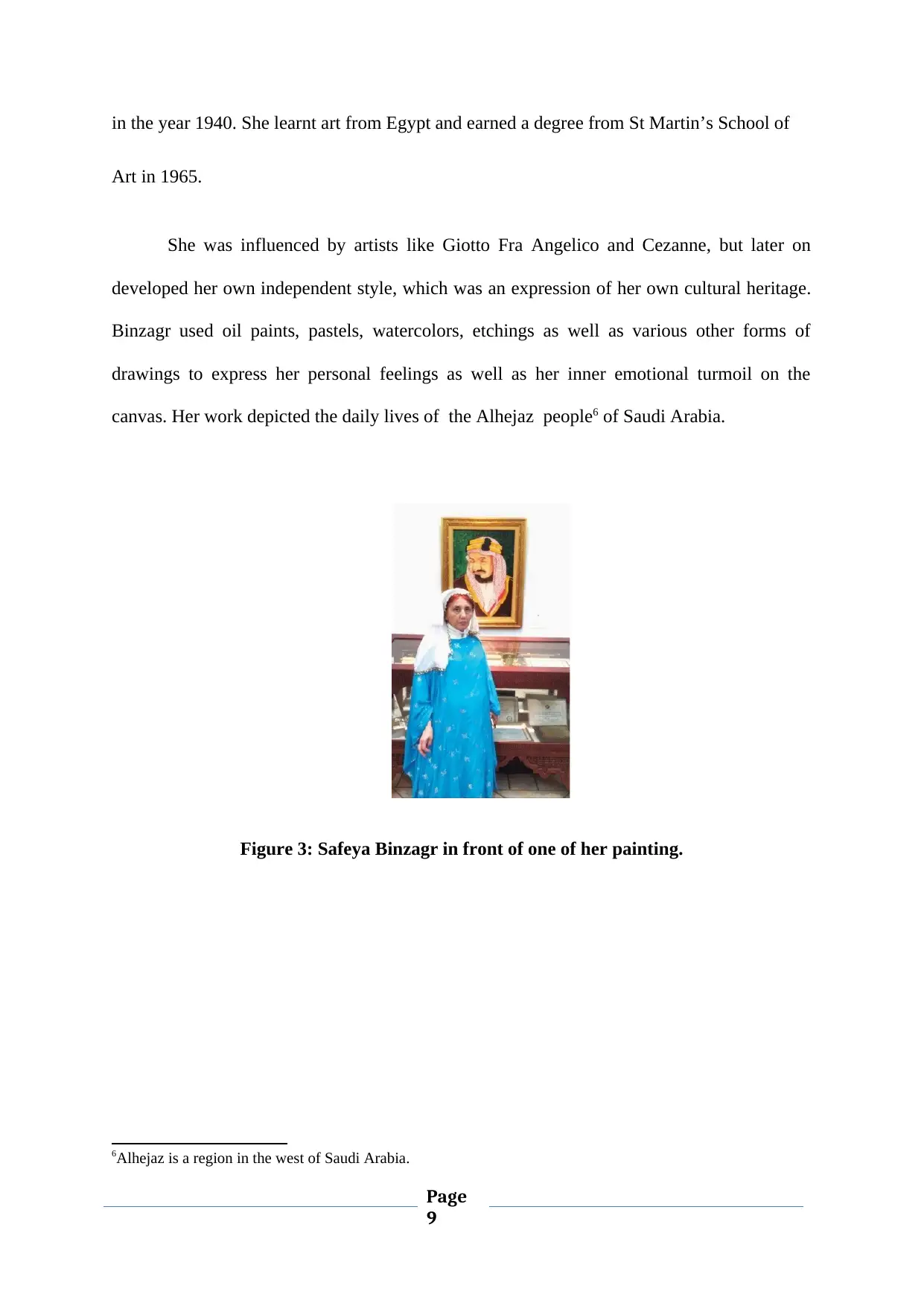
in the year 1940. She learnt art from Egypt and earned a degree from St Martin’s School of
Art in 1965.
She was influenced by artists like Giotto Fra Angelico and Cezanne, but later on
developed her own independent style, which was an expression of her own cultural heritage.
Binzagr used oil paints, pastels, watercolors, etchings as well as various other forms of
drawings to express her personal feelings as well as her inner emotional turmoil on the
canvas. Her work depicted the daily lives of the Alhejaz people6 of Saudi Arabia.
Figure 3: Safeya Binzagr in front of one of her painting.
6Alhejaz is a region in the west of Saudi Arabia.
Page
9
Art in 1965.
She was influenced by artists like Giotto Fra Angelico and Cezanne, but later on
developed her own independent style, which was an expression of her own cultural heritage.
Binzagr used oil paints, pastels, watercolors, etchings as well as various other forms of
drawings to express her personal feelings as well as her inner emotional turmoil on the
canvas. Her work depicted the daily lives of the Alhejaz people6 of Saudi Arabia.
Figure 3: Safeya Binzagr in front of one of her painting.
6Alhejaz is a region in the west of Saudi Arabia.
Page
9
Paraphrase This Document
Need a fresh take? Get an instant paraphrase of this document with our AI Paraphraser
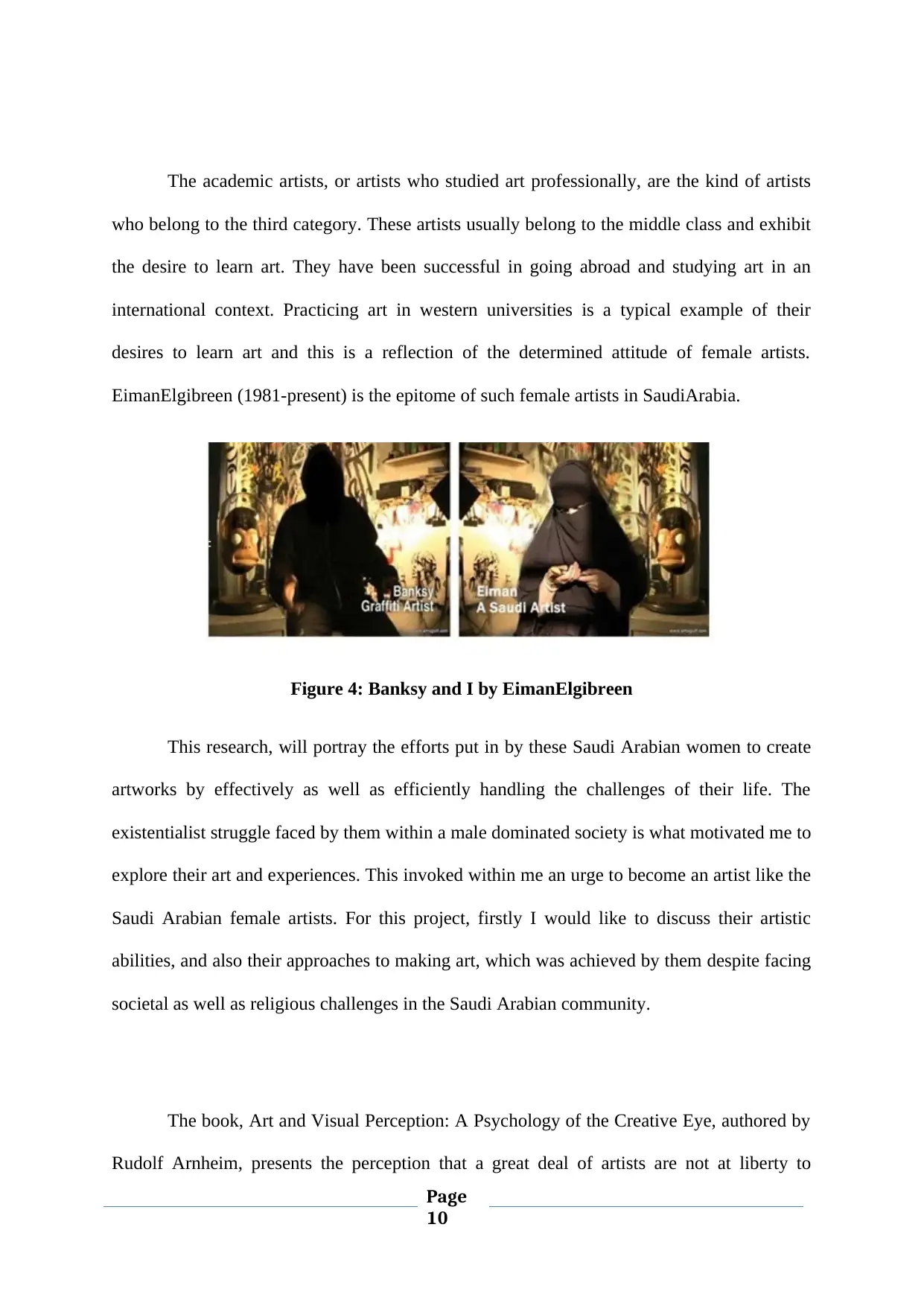
The academic artists, or artists who studied art professionally, are the kind of artists
who belong to the third category. These artists usually belong to the middle class and exhibit
the desire to learn art. They have been successful in going abroad and studying art in an
international context. Practicing art in western universities is a typical example of their
desires to learn art and this is a reflection of the determined attitude of female artists.
EimanElgibreen (1981-present) is the epitome of such female artists in SaudiArabia.
Figure 4: Banksy and I by EimanElgibreen
This research, will portray the efforts put in by these Saudi Arabian women to create
artworks by effectively as well as efficiently handling the challenges of their life. The
existentialist struggle faced by them within a male dominated society is what motivated me to
explore their art and experiences. This invoked within me an urge to become an artist like the
Saudi Arabian female artists. For this project, firstly I would like to discuss their artistic
abilities, and also their approaches to making art, which was achieved by them despite facing
societal as well as religious challenges in the Saudi Arabian community.
The book, Art and Visual Perception: A Psychology of the Creative Eye, authored by
Rudolf Arnheim, presents the perception that a great deal of artists are not at liberty to
Page
10
who belong to the third category. These artists usually belong to the middle class and exhibit
the desire to learn art. They have been successful in going abroad and studying art in an
international context. Practicing art in western universities is a typical example of their
desires to learn art and this is a reflection of the determined attitude of female artists.
EimanElgibreen (1981-present) is the epitome of such female artists in SaudiArabia.
Figure 4: Banksy and I by EimanElgibreen
This research, will portray the efforts put in by these Saudi Arabian women to create
artworks by effectively as well as efficiently handling the challenges of their life. The
existentialist struggle faced by them within a male dominated society is what motivated me to
explore their art and experiences. This invoked within me an urge to become an artist like the
Saudi Arabian female artists. For this project, firstly I would like to discuss their artistic
abilities, and also their approaches to making art, which was achieved by them despite facing
societal as well as religious challenges in the Saudi Arabian community.
The book, Art and Visual Perception: A Psychology of the Creative Eye, authored by
Rudolf Arnheim, presents the perception that a great deal of artists are not at liberty to
Page
10
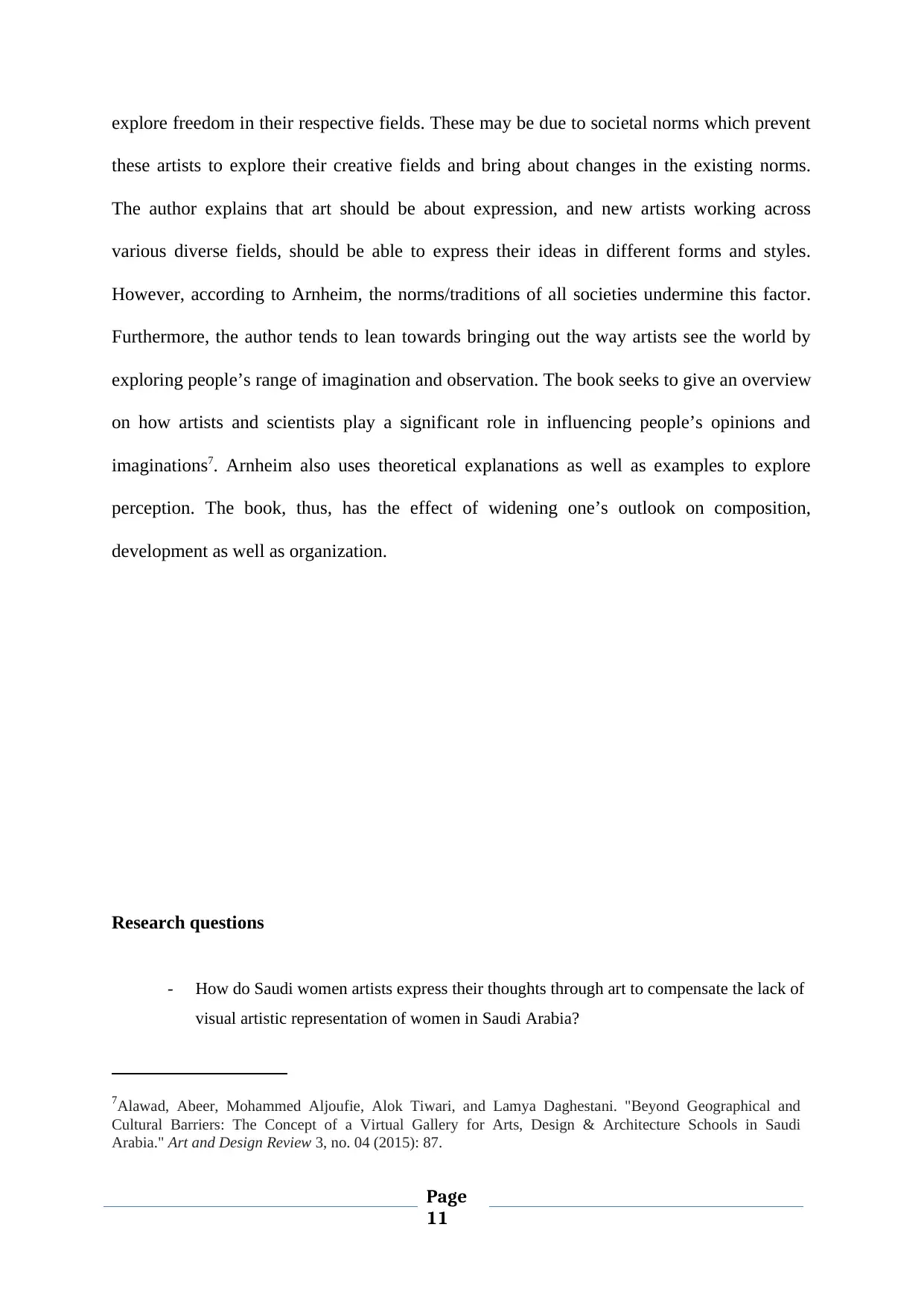
explore freedom in their respective fields. These may be due to societal norms which prevent
these artists to explore their creative fields and bring about changes in the existing norms.
The author explains that art should be about expression, and new artists working across
various diverse fields, should be able to express their ideas in different forms and styles.
However, according to Arnheim, the norms/traditions of all societies undermine this factor.
Furthermore, the author tends to lean towards bringing out the way artists see the world by
exploring people’s range of imagination and observation. The book seeks to give an overview
on how artists and scientists play a significant role in influencing people’s opinions and
imaginations7. Arnheim also uses theoretical explanations as well as examples to explore
perception. The book, thus, has the effect of widening one’s outlook on composition,
development as well as organization.
Research questions
- How do Saudi women artists express their thoughts through art to compensate the lack of
visual artistic representation of women in Saudi Arabia?
7Alawad, Abeer, Mohammed Aljoufie, Alok Tiwari, and Lamya Daghestani. "Beyond Geographical and
Cultural Barriers: The Concept of a Virtual Gallery for Arts, Design & Architecture Schools in Saudi
Arabia." Art and Design Review 3, no. 04 (2015): 87.
Page
11
these artists to explore their creative fields and bring about changes in the existing norms.
The author explains that art should be about expression, and new artists working across
various diverse fields, should be able to express their ideas in different forms and styles.
However, according to Arnheim, the norms/traditions of all societies undermine this factor.
Furthermore, the author tends to lean towards bringing out the way artists see the world by
exploring people’s range of imagination and observation. The book seeks to give an overview
on how artists and scientists play a significant role in influencing people’s opinions and
imaginations7. Arnheim also uses theoretical explanations as well as examples to explore
perception. The book, thus, has the effect of widening one’s outlook on composition,
development as well as organization.
Research questions
- How do Saudi women artists express their thoughts through art to compensate the lack of
visual artistic representation of women in Saudi Arabia?
7Alawad, Abeer, Mohammed Aljoufie, Alok Tiwari, and Lamya Daghestani. "Beyond Geographical and
Cultural Barriers: The Concept of a Virtual Gallery for Arts, Design & Architecture Schools in Saudi
Arabia." Art and Design Review 3, no. 04 (2015): 87.
Page
11
⊘ This is a preview!⊘
Do you want full access?
Subscribe today to unlock all pages.

Trusted by 1+ million students worldwide
1 out of 47
Related Documents
Your All-in-One AI-Powered Toolkit for Academic Success.
+13062052269
info@desklib.com
Available 24*7 on WhatsApp / Email
![[object Object]](/_next/static/media/star-bottom.7253800d.svg)
Unlock your academic potential
Copyright © 2020–2025 A2Z Services. All Rights Reserved. Developed and managed by ZUCOL.



